

The North American Blue Mold Forecast Center at North Carolina State University predicted on April 14 that a low level risk existed for blue mold spores to be introduced into Kentucky (especially eastern and central Kentucky) on April 14. This was an especially difficult forecast to develop, due to the complexity of the weather systems involved and a number of unknowns about the blue mold situations in the southeast and southwest USA. The sources of spores would have been from active disease in cultivated tobacco in southern Georgia and wild tobacco in southern Texas.
The actual weather events developed similar to the advanced forecast, but the weather system moved more slowly than expected and produced less moisture. As a result, the overall risk of viable spore deposition should have been reduced and shifted. This should have shifted the spore deposition events westward, to west central and southern Kentucky and away from eastern and central Kentucky. In unheated, outdoor transplant production situations, it is unlikely that infection would have taken place on Wednesday and Thursday nights (April 14 and 15) because of the drying effects of high surface winds and low temperatures. However, conditions in poorly managed greenhouses could have been ideal for infection where viable spores arrived on warm, wet leaves unprotected by fungicide.
Growers are urged to keep all transplant production systems protected with regular fungicide sprays (with either Dithane or Ferbam) in order to kill spores arriving as they attempt to germinate and infect the leaf. Realize that these two fungicides have no ability to kill the fungus once infection has occurred. They work only by killing the fungus before or during germination and do not penetrate the leaf surface. In visiting several transplant production operations during the past week, the main problems I see relate to poor coverage of fungicides.
Complete coverage of the tobacco seedling is critical for disease control. With the kind of weather now being experienced, the spray interval should be closed to twice-weekly with Ferbam or 5-day interval with Dithane. Plants are growing fast, and maintaining coverage of the new growth is important. Realize these protectant-type fungicides do not move around on the leaf after application, especially in the float systems. They stay where they land! Adjust the sprayer so that a fine mist is being applied, rather than large drops, and adjust the spray interval to insure new growth is covered. Regular clipping, including immediately prior to the fungicide application, helps to open the canopy, improving fungicide coverage.
![]() The Kentucky Blue Mold Warning System's web address is:
The Kentucky Blue Mold Warning System's web address is:
http://
www.uky.edu/Agriculture/kpn/kyblue/kyblue.htm

Warm, wet weather is really going to bring wheat growth on fast. As this crop changes from vegetative to reproductive stages, the importance of spring insect control becomes considerable. At this point we still have three possible problems; though none of the three are probable.
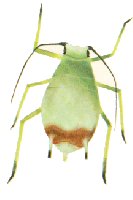 Our year long foe, the aphid, is still around.
However, the impact of this pest has changed. It is
much too late in the year to worry about the aphids
vectoring Barley Yellow Dwarf Virus, whatever is
done, is done. However, as your grain begins to
head, large numbers of aphids can cause problems.
During grain filling period an aphid population of
50 for more per head would warrant an insecticidal
application. Large numbers of aphids will not
reduce grain yields but may have an effect on test
weight.
Our year long foe, the aphid, is still around.
However, the impact of this pest has changed. It is
much too late in the year to worry about the aphids
vectoring Barley Yellow Dwarf Virus, whatever is
done, is done. However, as your grain begins to
head, large numbers of aphids can cause problems.
During grain filling period an aphid population of
50 for more per head would warrant an insecticidal
application. Large numbers of aphids will not
reduce grain yields but may have an effect on test
weight.

Cereal leaf beetle will also make an appearance in some fields. This is a very sporadic pest and does most of its damage to the Flag and F1 leaves. You should watch for this pest all during grain fill.
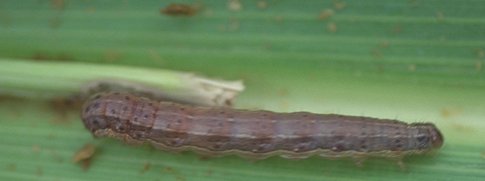 Armyworm moths have been flying in a pretty big
way for about three weeks. This pest will be a
threat all the way to harvest. Like the cereal leaf
beetle, armyworms cause most problems while
feeding on the Flag and F1 leaves. However, this
pest also can reduce yields by 'clipping' wheat
heads off the plant. While the armyworms do not
feed on them heads, the heads are lost to the
producer.
Armyworm moths have been flying in a pretty big
way for about three weeks. This pest will be a
threat all the way to harvest. Like the cereal leaf
beetle, armyworms cause most problems while
feeding on the Flag and F1 leaves. However, this
pest also can reduce yields by 'clipping' wheat
heads off the plant. While the armyworms do not
feed on them heads, the heads are lost to the
producer.
BEFORE KILLING INSECTS MAKE SURE IT WILL
PAY. The fact that an insect pest is present does
NOT mean that you should spray. All of these
insects will be present at some level in most any
Kentucky wheat field. However, odds are there will
not be enough of them to cause an economic loss.
The best measure of whether or not to spray is to
use an economic threshold. If you treat when pest
populations are too low, you will be spending
dollars needlessly. In the current economic climate
one can ill afford to do that! Economic Thresholds
for wheat insect pest can be found in the Small
Grains IPM Manual, (IPM-4) The Comprehensive
Wheat Management Guide, (ID-125) and
Insecticide Recommendations for Small Grains
(ENT-47).
For more information on wheat insects check the
above listed publications and our list of Entfact
publications at:
http://www.uky.edu/Agriculture/Entomology/entfacts.htm
Each fungicide labeled on wheat has specific diseases it will control, but effectiveness is dependent on many factors in addition to fungicide active ingredient. These factors include rate of active ingredient applied, application method, spray volume and pressure, adjuvants used, timing of application (relative to crop stage and disease incidence and severity), conditions during and immediately following application, and fungicide type (e.g., contact vs. systemic). The table below estimates the relative effectiveness of the various fungicides labeled for wheat in Kentucky. The table assumes that the relevant variables are taken out of the equation except for fungicide active ingredient and, in some cases, rate of fungicide applied.
When comparing the disease control potentials for the various wheat fungicides listed, realize that in the real world you are very unlikely to be able to control all the external factors which might impact fungicide activity. The table assumes a "best case scenario" for each fungicide. For a fungicide such as mancozeb, this best case scenario is frequently difficult to achieve. Mancozeb MUST be applied prior to infection and it is a surface protectant. Thus, application must be thorough and tissue emerging after application will, for all practical purposes, be unprotected. These limitations explain the frequent disease control failures when mancozeb is used. However, the problem is not with the fungicide; it is the application of that fungicide. Another caveat in the below table is that data are often very limited when it comes to making direct functional comparisons for certain fungicide treatments. For example, we now have many years of experience with Tilt and we know fairly well what to expect from that fungicide if it is applied at or before Feeke's stage 8 (flag leaf emergence). However, the data base for delayed application of Tilt, such is as allowed by the 24C label in Kentucky, is somewhat poorly defined. With Quadris, the big question concerns the activity of that fungicide at different use rates. Many of the studies I have seen involving Quadris evaluated a use-rate midway between the low and the high rates currently labeled. Others looked at the highest labeled rate, but did not evaluate effectiveness at the lowest labeled rate. The upshot of all this is that we really don't know what Quadris will do at the low rate, nor are we certain what it is capable of at the highest labeled rate. To make matters worse, few studies have directly compared the efficacy of Tilt and Quadris when applied at the same time. In many studies Quadris appears to be superior to Tilt, but then you see that Tilt was applied at flag leaf emergence and Quadris was appled during head emergence. Even if Tilt and Quadris were equal in effectiveness, in most cases we would expect the later application to be more effective. Thus, some of the extant studies and data can be misleading if you do not take care to examine what was done. This is why I indicated above that the table is an estimate of relative effectiveness of the various wheat fungicides.
| Fungicide | Powdery Mildew | Leaf Blotch Complex* /Glume Blotch |
Leaf Rust | Tan Spot | Effective Period(days) |
| Bayleton | E* |
P-F |
P-VG |
P |
14-21 |
| Benlate | F |
F |
P |
P |
14-21 |
| Mancozeb | P |
G |
G |
F |
7-10 |
| Quadris | F-G |
VG |
E |
VG |
21-28 |
| Tilt | VG |
VG |
VG |
G |
21-28 |
*Leaf blotch complex refers to Septoria leaf blotch caused
by Septoria tritici, and Stagonospora leaf and glume
blotch caused by Stagonospora nodorum.
**P=Poor, G=Good, VG=Very Good, E=Excellent; when
a range of activity is indicated better activity is
associated with the highest labeled rate.
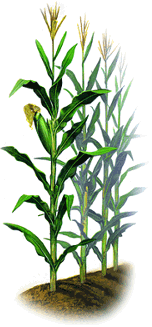
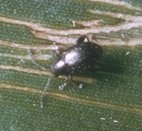 This past winter has been mild and will favor higher than
normal flea beetle numbers. Flea beetles overwinter
as adults near corn fields and are active in weeds early
in the spring. The corn flea beetles are very small, dark
insects. They jump readily when disturbed, hence the
name flea beetles. While we are likely to see higher
numbers this year, flea beetle infestations can be highly
variable, so fields need to be monitored regularly.
This past winter has been mild and will favor higher than
normal flea beetle numbers. Flea beetles overwinter
as adults near corn fields and are active in weeds early
in the spring. The corn flea beetles are very small, dark
insects. They jump readily when disturbed, hence the
name flea beetles. While we are likely to see higher
numbers this year, flea beetle infestations can be highly
variable, so fields need to be monitored regularly.
Flea beetles are important in corn for two reasons, first, they are leaf feeders and large infestations can kill small seedlings. Feeding by these beetles results in scaring of the leaf surface and evidenced by a frosted appearance to the leaves. Serious damage can occur on plants less than six inches tall. Flea beetles are also vectors of Stewart's Wilt, also known as bacterial leaf blight.
With most hybrids under good growing conditions the corn seedlings will recover from moderate levels of early-season flea beetle damage, so control is not needed unless some plants are killed or taking on a whitish cast. Control is rarely justified, unless damage is extensive and growing conditions are poor. If an insecticide is needed for corn flea beetle control, see ENT-16 for a list of recommended insecticides. Fields with a history of Stewart's Wilt or fields with Stewart's Wilt susceptible hybrids should be scouted carefully. Most field corn varieties are not as susceptible to this disease as sweet corn.
The cool and wet soil conditions that developed from the recent cold front increases the risk of injury from chloroacetamide herbicides. These environmental conditions tend to slow the metabolism and emergence of corn plants and allows more exposure time of the corn coleoptile to herbicides in soil solution. The coleoptile is the membranous sheath that covers the corn shoot and is the site of uptake of these herbicides during the process of seed germination and plant emergence.
Injury symptoms from chloroacetamide herbicides include malformed and stunted seedlings with twisted leaves that do not unroll properly. Plants that are severely injured may eventually die because leaves cannot unroll. The symptoms caused by chloroacetamides are often confused with those associated with growth-regulator herbicides such as 2,4-D or dicamba. Growth regulator herbicides may cause abnormalities of both shoots and roots of corn plants, whereas, chloroacetamides tend to affect only the shoot growth.
Chloroacetamide herbicides are widely used for weed management in corn and include acetochlor (Fieldmaster, Fultime, Harness, Harness Extra, Surpass, TopNotch); alachlor (Bullet, Micro-Tech, Partner); dimethenamid (Frontier, Guardsman, LeadOff) flufenacet (Axiom, Epic); and metolachlor (Bicep, Bicep II, Bicep II Magnum, Broadstrike SF+Dual, Dual, Dual II, Dual II Magnum). Although all chloroacetamides can injure corn, acetochlor and metolachlor tend to have a greater potential to cause injury compared with alachlor, dimethenamid, or flufenacet. All acetochlor products and metolachlor products with the Roman numeral "II" included in the trade name are formulated with a safener to limit the risk of injury.
Arguably, the most common and most damaging
insect pests that attacks apples is the plum curculio.
However, it also is one of the easiest pests to
control, if treatments are timed properly.
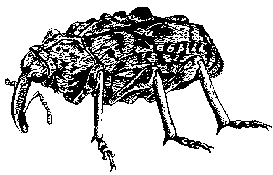 Uncontrolled, this pest can damage 60 to 80% of an
apple crop in a week. The adult curculio becomes
active in the early spring when nighttime low
temperatures begin to exceed 60 F. It flies to trees
and feeds on buds, flowers, and newly set fruit over
a five to six week period. This results in cat-facing of
the fruit due to feeding and egg-laying injuries.
Surface feeding and egg-laying by the
overwintering adults can scar or misshape the fruit
by harvest, while feeding by the larvae causes
premature fruit drop. In peaches, gummy material
often oozes from the wound.
Uncontrolled, this pest can damage 60 to 80% of an
apple crop in a week. The adult curculio becomes
active in the early spring when nighttime low
temperatures begin to exceed 60 F. It flies to trees
and feeds on buds, flowers, and newly set fruit over
a five to six week period. This results in cat-facing of
the fruit due to feeding and egg-laying injuries.
Surface feeding and egg-laying by the
overwintering adults can scar or misshape the fruit
by harvest, while feeding by the larvae causes
premature fruit drop. In peaches, gummy material
often oozes from the wound.
Insecticide applications timed at the petal-fall and first cover stages for apples, and the petal-fall and shuck-split stages in peaches and cherries, will control adults and prevent fruit damage. Serious plum curculio damage is usually restricted to orchards that do not use both these insecticide applications. Home gardeners can help reduce future problems by picking up these damaged apples as they fall off the tree and destroying them before the adults emerge.

Several homeowners have been concerned about bees hovering over bare areas of the lawn and burrowing into the ground. Samples sent in for identification have been plasterer bees. They are the same size as honey bees but have a black body and fine whitish hairs. They have neither the golden markings of honey bees nor the bright yellow colors of yellowjackets. Plasterer bees tunnel into the ground to build brood chambers in which to rear their young. Although they are solitary bees, rather than living in complex colonies, large numbers of them can build up in a favorable area over time. Information with one sample indicated that the bees were active there last year, too.
There are several other families of ground nesting bees; some species are brightly colored. They are intent on visiting flowers to collect nectar and pollen. They are among the wide range of "wild bees" that are important pollinators. Numbers of these insects may have increased in response to the recent decline of honey bees due to tracheal and Varroa mites.
These bees are not aggressive but can be a problem in yards where children are playing or a general nuisance. If control is necessary, the steps for treating yellowjacket nests, as described in Entfact 620 .
Insecticide-Impregnated Cattle Ear Tags
Insecticide-impregnated cattle ear tags release small amounts of an insecticide which are distributed over the animal during grooming or rubbing. In general, ear tags have provided excellent, long term control of horn flies and a reduction in face fly numbers.
Factors to consider when using these products:
Read the label before you purchase and use insecticide ear tags. All tags are labeled for beef cattle while only those with certain active ingredients are approved for use on lactating dairy cattle. Check for any limitations for use, such as animal age. Look for the common name of the active ingredient (for example, permethrin). In some cases, different brands of tags contain the same active ingredient. You can save money by comparison shopping, or avoid inadvertently using the same active ingredient if resistance is a potential problem. Consider the recommended number of tags per head. Some brands are used at the rate of one per animal. UK research trials have generally shown that systems which use two tags per animal seem to provide better face fly control than those which rely on a single tag.
Animals only need to be handled one time to apply the tags. However, this is not necessarily when you would normally work your animals. For fly control, it is best to tag animals after horn fly numbers reach 50 or more per side. This reduces the chances of developing resistance to the active ingredients that are being used. Normally, tags provide 12 to 15 weeks of fly control. Tagging too early in the season can mean that the tags are not providing good control in the fall that will help to control the overwintering population.
With insecticidal ear tags, the control system moves with the animals. This may be an advantage if animals are moved at intervals and dust bags or back rubbers are not in place in every pasture or grazing area.
There are three main types based on the active ingredient(s) that they contain.
1. Organophosphate (OP) insecticides such as diazinon, fenthion, pirimofos methyl, or a diazinon + chlorpyrifos combination. These tags provide good horn fly control and moderate face fly control.
2. Synthetic pyrethroid (SP) insecticides- fenvalerate and permethrin are the original members of this group. These tags are sold under a variety of brand names. Usually they are less expensive than the new, more expensive synthetic pyrethroids, such as cyfluthrin, lambda-cyhalothrin, and zeta- cypermethrin. These tags provide good horn fly control and better face fly control than the OP tags.
The two groups of tags contain insecticides that attack the nervous system of the fly in different ways. Seasonal rotation between an OP and an SP insecticide can be useful in combating insecticide resistance that has developed in horn flies in some areas of the state. Resistance, indicated by a failure in horn fly control, can develop when tags containing the synthetic pyrethroid permethrin have been used for several consecutive seasons. No resistance to organophosphates, or the new synthetic pyrethroids, has been seen.
3. A relatively new group of combination tags has appeared. These couple an OP and a SP in the same tag. Current examples pair lambda-cyhalothrin and pirimiphos methyl or cypermethrin and chlorpyrifos. The assumption is that the OP would control SP-resistant horn flies.
Are there any safety precautions associated with using insecticide ear tags?
Non-permeable gloves should be worn when tagging animals. This is clearly shown in the application pictures on the containers of some tag brands. The hands shown applying the tags clearly have gloves. Comparable pictures with other brands do not obviously show gloves, although label statements indicate that they should be worn.
Insecticidal ear tags should not be handled bare-handed. The concentration of insecticide in the tags varies from 8% to 36%. The tags are manufactured so that the insecticide is rubbed off the surface and onto the animal. Any handling of the tags leaves some insecticide on the hands. The insecticide then can be transferred easily to the mouth, eyes, face or other areas of the body. Some individuals may be very sensitive to the active ingredients in the tags.
Signal words on the label range from CAUTION to WARNING. Several products carry statements about the potential for allergic reaction following exposure. Many are easily absorbed through the skin or eyes, some have irritation vapors. Wear protective gloves and wash hands thoroughly with soap and water after tagging or when taking a break.
If chemical fungicides are used in the home landscape and garden to prevent primary infections by disease-causing fungi, they are most often used in springtime. County Extension Agents can advise their clients that there is a pretty good selection of fungicides available for use in the home garden. Some of the brand names having fungicides for home garden use include Black Leaf, Dragon, Green Charm, Green Light, Hi-Yield, K-Gro, Ortho, Pro Care, Rigo's Best, Safer, Security, Spectracide, and others. One or more of these brands are available at most of the local garden shops, discount chain stores, farm and garden stores, and home improvement chain stores.
General Protectant Fungicides. Look for the following active ingredients for broad-spectrum fungicides that are best used before disease begins.
Captan - combination fungicide-insecticide sprays often contain captan (6.8 - 14%) combined with one or more insecticides such as malathion, carbaryl, or methoxychlor. It can be found in Captan Garden Spray, Fruit Guard, Home Orchard Multipurpose Spray, Liquid Fruit Tree Spray, or Rose and Flower Dust which are used mostly for diseases of fruit trees, but which are also used for grapes, strawberries, shrubs and flowers. Captan can also be found as a single active ingredient (48.9%) in Garden Spray for a variety of garden plant diseases.
Chlorothalonil (29.6%) - is found in Daconil 2787, Liquid Lawn Disease Control, and Multi-Purpose Fungicide under several brand names; it can be used for diseases of lawns, shrubs, trees, fruits, vegetables, and flowers.
Copper - formulated as Bordeaux Mixture (12.5% copper) or other fixed copper products, this fungicide can be used on fruits, vegetables, shrubs, trees, and flowers and still satisfy the requirements for most organic growing uses.
Ferbam (76%) - is found in Ferbam Wettable Fungicide for diseases of fruit trees, grapes, and ornamentals.
Lime-Sulfur (26 - 29% calcium polysulfides) - is prepared as Dormant Disease Control or Lime Sulphur Spray; this fungicide is used for suppressing pathogens of some fruit trees, small fruits, roses, shrubs, and shade trees just before new spring growth appears. This material is suitable for most organic disease control practices.
Maneb (80%) - is found in Maneb Lawn and Garden Fungicide intended for control of diseases of shrubs, flowers and turfgrass in the home landscape, and for vegetables such as beans, cucumbers, peppers, tomatoes, and watermelons.
Sulfur (0.4% [ready-to-use formulation] - 90%) - is found in Garden Fungicide, and Wettable Sulfur. As a mixture with carbaryl and pyrethrin insecticides, sulfur (30%) can also be found in Multi-Purpose Rose and Floral Dust and Multi- Purpose Tomato Vegetable Dust. Sulfur can be used on fruit trees, small fruits, ornamentals, shrubs, flowers, and vegetables. It also satisfies organic disease control schemes.
Systemic Fungicides. These fungicides are often specific for certain diseases of mainly landscape plants. Although they are systemic, they also are best applied before the disease gets out of hand.
Benomyl (25%) - as Benomyl Systemic Fungicide, it is used for fruits, flowers, vegetables, and lawns.
Myclobutanil (1.55%) - as Immunox or Multipurpose Fungicide, this is the newest of the systemic fungicides to be available to homeowners. Immunox + (0.78% myclobutanil) is formulated in combination with permethrin insecticide. This fungicide is used on roses, lawns, flowers, and ornamental shrubs and trees.
Thiophanate-methyl (50%) - available as Rose and Ornamental fungicide, it has similar activity to benomyl and is used for diseases of flowers, ornamentals, and shade trees.
Triforine - sold as Rose Pride Funginex (6.5% triforine) or as Rose Pride Orthenex (3.25% triforine) when mixed with the insecticide acephate, this fungicide can be used for control of diseases of roses, certain fruit trees, ornamentals, and shrubs.
A bactericide. Some stores sell the one available effective bactericide in quantities homeowners can use.
Streptomycin sulfate - Liquid Fruit Tree Spray is used for control of fire blight disease of apples and pears.
Once a disease has been identified, chemical controls are generally not needed in the home garden because it is either too late, or cultural practices can be about as effective. For valuable crops and plants, gardeners who choose to use fungicides have many choices for chemical disease control. Fungicides packaged for homeowner use are generally safe to use, provided that gardeners take sensible precautions. These fungicides are usually formulated as low concentrations of active ingredient and are sold in small quantities, thus minimizing misuse of the chemicals. Follow product label instructions for correct fungicide use.
We are continuing to see Sclerotinia crown and stem rot on fall-seeded alfalfa, mostly in central Kentucky.
For the most part, tobacco diseases so far have been
minimal, but we are beginning to see some of the
typical seedling float diseases, such as Pythium root
rot and Rhizoctonia damping-off. We have also
already seen one case of Sclerotinia collar rot this
year.
**Note in particular: We recieved a sample of
black shank in float plants last week. Watch float
beds carefully for intense yellowing of foliage that
accompanies black shank infections.
On ornamentals, we have diagnosed a case of impatiens necrotic spot virus on greenhouse impatiens and Botrytis blight on narcissus in the landscape. We are seeing many environmental/ stress-related problems on needle evergreens, particularly white pine, spruce and taxus. Discoloration and dropping of needles may be the result of accumulated stresses from the previous two wet springs, followed by dry late summer and fall weather.

| UKREC-Princeton | |
| True Armyworm | 89 |
| Black Cutworm | 7 |
By Lee Townsend
Click here for the Training and Testing Schedule on the Pesticide Applicator Training web site
Lee Townsend
Extension Entomologist